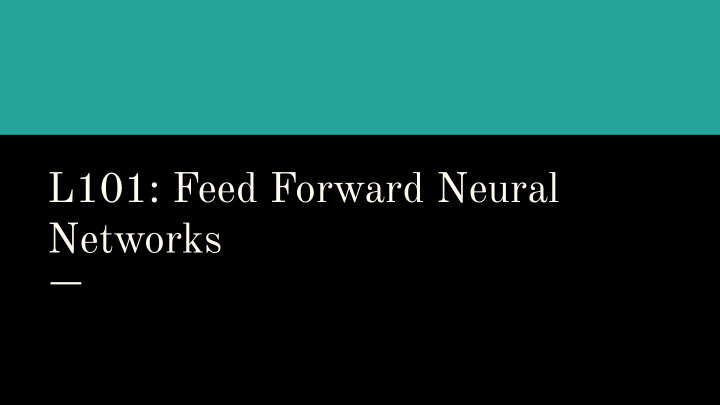



L101: Feed Forward Neural Networks
Linear classifiers e.g. binary logistic regression: And their limitations: http://www.ece.utep.edu/research/webfuzzy/docs/kk-thesis/kk-thesis-html/node19.html
What if we could use multiple classifiers? Decompose predicting red vs blue in 3 tasks: ● top-right red circles vs. rest ● bottom-left red circles vs. rest ● If one of the above is red circle, then it is red circle, otherwise blue cross Transform non-linearly into linearly separable!
Feed forward neural networks More concretely: Terminology: input units x, hidden units h Can think of the hidden units as learned features More compactly for k layers :
Feed forward neural networks: Graphical view Feedforward: no cycles, the information flows forwards Fully connected layers Barbara Plank (AthNLP lecture)
Computation Graph view It is useful when differentiating and/or optimizing the code for speed What should input x be for text classification? Word embeddings! Barbara Plank (AthNLP lecture)
Activation functions Non-linearity is key: without it we still do linear classification Multilayer perceptron is a misnomer Hughes and Correll (2016)
How to learn the parameters? Supervised learning! Given labeled training data of the form: Optimize the Negative Log-Likelihood, e.g. with gradient descent: What could go wrong? We can only calculate the derivatives of the loss for the final layer, we do not know the correct values for the hidden ones. The latter with non-linear activations make the objective non-convex .
Backpropagation We can obtain temporary values for the hidden layer and final loss (forward pass) and then calculate the gradients backwards: https://srdas.github.io/DLBook /TrainingNNsBackprop.html
Backpropagation (toy example) Ryan McDonald (AthNLP 2019)
Regularization L2 is standard Early stopping based on validation error Dropout (Srivastava et al., 2014): remove some connections (at random, different each time) in order to make the rest work harder https://srdas.github.io/DLBook/ImprovingModelGeneralization.ht ml#ImprovingModelGeneralization
Optimization Noise from being stochastic in gradient descent can be beneficial as it avoid sharp local minima (Keskar et al. 2017)
Implementation ● Learning rates in (S)GD with backprop need to be small (we don’t know the values for the hidden layer, we hallucinate them) ● Batching the data points allows us to be faster on GPUs ● Learning objective non-convex: initialization matters ○ Random restarts to escape local optima ○ When arguing for the superiority of an architecture, ensure it is not just the random seed (Reimers and Gurevych, 2017) ● Initialize with small non-zero values ● Greater learning capacity makes overfitting more likely: regularize Let’s try some of this
Sentence pair modelling We can use FFNNs to perform tasks involving comparisons between two sentences, e.g. textual entailment: does the premise support the hypothesis? Premise : Children smiling and waving at a camera Hypothesis : The kids are frowning Label : Contradiction Well-studied task in NLP, was revolutionized Bowman et al. (2015)
Interpretability What do they learn? Two families of approaches: ● Black box: alter the inputs to expose the learning, e.g. LIME ● White box: interpret the parameters directly, e.g. learn the decision tree ○ Alter the model to generate an explanation in natural language ○ Encourage parameters to be explanation-like What is an explanation? ● Explains the model prediction well? ● What a human would have said to justify the label?
Why should we be excited about NNs? Continuous representations help us achieve better accuracy Open avenues to work on more tasks that were not amenable with discrete features: ● Multimodal NLP ● Multi-task learning Pretrained word embeddings are the most successful semi-supervised learning method I know of (Turian et al., 2010)
Why not be excited? We don’t quite understand them: arguments about architecture/regularization suitability to task do not seem to be tight (the field is working on it) Need for (more) data Feature engineering is replaced by architecture engineering Bowman et al. (2015)
What can we learn with FFNNs? Universal approximation theorem tells us that with one hidden layer with enough capacity can represent any function (map between two spaces). Then why do we design new architectures? Being able to represent, doesn’t mean able to learn the representation: ● Adding more hidden units becomes infeasible/impractical ● Optimization can find poor local optimum, or overfit Different architectures can be better to learn with for different tasks/datasets We can compress large trained models with simple ones, but not learn the simpler ones directly (Ba and Caruana, 2014)
Bibliography A simple implementation in python of backpropagation The tutorial of Quoc V . Le A nice, full-fledged explanation of back-propagation Similar material from an NLP perspective is covered in Yoav Goldberg's tutorial, sections 3-6 Chapter 6, 7 and 8 from Goodfellow, Bengio and Courville (2016) Deep Learning
Recommend
More recommend